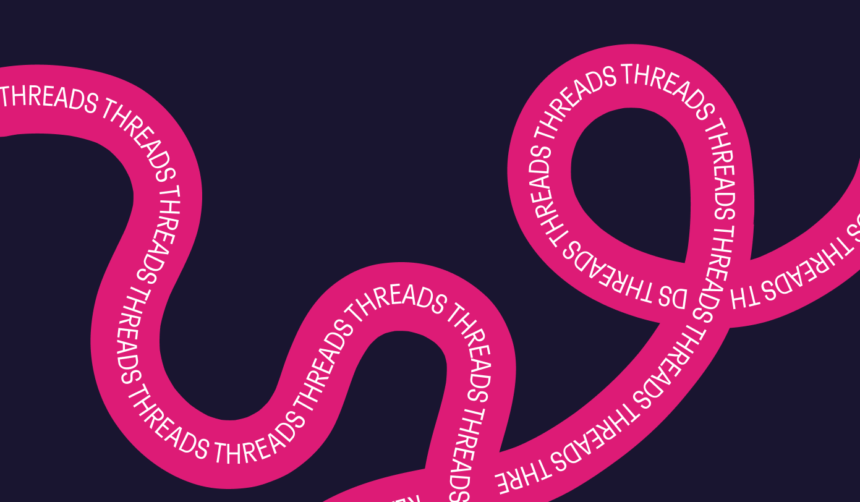The launch of Meta’s new app Threads is a unique moment in the history of social media.
Most social networks start from scratch, and their culture evolves over time under the influence of early adopters and users.
Threads is different. Helped by an easy integration with Instagram users’ pre-existing social graphs, it had tens of millions of signups in its first week.
But none of these new users quite know what the vibe is yet. They’ve all had an invite to the party, but no-one knows the dress code.
As we’ve pointed out with social media before, figuring out this elusive vibe is vital if brands, publishers, and advertisers want to really succeed on a platform.
So with that in mind, here’s some key insights into Threads’ first batch of users.
The basics
As of August 2023, 1 in 10 internet users worldwide have tried Threads. Three-quarters of those early users say they’re likely to use it again, with half saying it’s very likely they’ll do so, making Threads’ chances of sticking around pretty good.
The biggest reason why people have signed up is – you guessed it – because of its convenient integration with Instagram. But this goes deeper than just importing friends lists and followers; the second most popular reason people signed up was because they like the Instagram brand.
Trust of social media companies isn’t that high on the whole, but our research shows that Instagram is seen as one of the more positive places on the internet.
But while Instagram was the cause of many initial signups, Threads’ early users are gravitating to more of a Twitter-style, “information network”, use-case.
This is one of the key unanswered questions about Threads – will it be more like Instagram with text, or Twitter with pictures?
Thanks to our audience insights, we can provide a rough segmentation of Threads’ early user base in the US, and the biggest segment at the moment shows people expect it to look and feel a lot like Twitter.
Threads users are news consumers
Instagram and Threads boss Adam Mosseri has said he doesn’t want to encourage hard news and politics on the platform, but his user base seem to have other ideas.
As we’ve seen, right now Threads users skew (slightly) towards a more-like Twitter use case. These users include:
- Retweeters (26% of people who use the retweet button have used Threads, more than any other audience)
- MSNBC readers (24%)
- TIME readers (23%)
- People who follow journalists and news companies on social media (21%)
Meta has good reasons to be nervous about getting involved with the news industry – just look at what’s happening with link sharing in Canada – but that’s exactly what many of its early users are looking for.
At the time of writing Threads had just released its desktop version, which is likely to spark yet more interest from journalists and publishers who’ll now be able to write in more of a long-form style that suits news stories.
Threads users are community-focused, particularly in gaming
Another important segment is perhaps more surprising – people you might normally associate with community-focused platforms. Here Discord leads the way (23% of Discord users have tried Threads), but online multiplayer gaming spaces like MMOs and battle royale games also feature.
Brands and publishers are having to nurture new communities almost from scratch, and to do that they’ll have to lean on the most active community members. By collaborating and potentially cross-posting with other platforms, they may be able to import some of their most active conversations into a space that needs more interactions to get up and running.
Another way to look at this segment is to think of them as gamers, or people used to gamification. One of the biggest user groups on Threads is people who respond to polls on Instagram stories, among whom 24% have used Threads. So it’s not just heavy social media users with an interest in Threads, it’s also those who’re used to actively engaging with social content.
While Threads’ features may be limited at the moment, these constraints could spark creativity. For example this could be an interesting time to revisit classic campaigns from the early years of now-established social platforms – like Starbucks’ 2014 White Cup Contest on Instagram – for ideas on how to engage users in a new space.
If Threads’ early users stick around as much as they say they’d like to, first-mover advantage will be highly valuable. While Threads doesn’t have the great equalizer of its algorithmic feed, TikTok shows how successful challenger brands can be when they crack a platform’s vibe early. The Savannah Bananas baseball team is just one example of how a less well-known brand can gather more followers than its more popular peers.
Threads users are into fashion, art, and aesthetics
While Threads’ early users lean toward the news/information use case, others are expecting an Instagram-like feel and experience, including high-engaging audiences like:
- Fashion-conscious consumers (23% have used Threads)
- Fine art fans (20%)
- Modern art fans (18%)
This highlights the other big challenge Meta faces with Threads. As well as creating an appealing vibe in the hope of attracting an audience numbering tens of millions, they also need to appeal to both news fans and art fans, two camps that have historically found homes in different kinds of social media.
You could argue Meta has done this before. When it acquired Instagram in 2012, that led to an influx of users from Facebook and helped shift the app away from photographers and artists to a broader range of people. But that was more gradual, on a smaller scale, and in a very different environment.
Threads users are early adopters
No great surprise there; by their nature, new devices and platforms attract audiences interested in new things, especially new technology. Looking closer, Threads audience includes people who:
- Are interested in computers and coding (20% have used Threads)
- Follow the latest tech trends and news (20%)
- Buy laptops (20%)
- Use voice assistants (18%)
So it’s fair to say tech websites like Wired and TechCrunch are going to find many of their readers on the platform.
For brands and publishers more broadly, it may be worth tactically focusing on content from their tech sections, or from their tech journalists, during the initial stages of Threads’ development.
What the future might hold
There are two big questions about Threads right now.
The first is, will the early sign-ups stick around? Based on our research, we think the prospects are pretty good.
But that depends on the second question – is Threads a Twitter-style app that looks like Instagram, or an Instagram-style app that looks like Twitter?
There are plenty of factors to consider, but judging by Threads’ early users, the appetite for news, information, and long-form text content is there. Meta will have to decide at some point if they want to embrace this or not, as right now it’s what their users clearly want.
At the same time, they ideally need to satisfy a contingent crossing over from Instagram who want to keep that platform’s aesthetic. So a key challenge is to find a way to please both groups; if they can get this right they’ll be on their way.
 hbspt.cta.load(304927, ‘cef65490-1dba-4ede-a9b0-a5f41bb8f8d7’, {“useNewLoader”:”true”,”region”:”na1″});
hbspt.cta.load(304927, ‘cef65490-1dba-4ede-a9b0-a5f41bb8f8d7’, {“useNewLoader”:”true”,”region”:”na1″});








